
Facebook Marketing: Everything You Need To Know In 2025
Whether you have a brick-and-mortar store, an eCommerce site, or a blog, Facebook marketing gives you the power to nurture existing and potential customers and maximize conversions.
Wondering why is Facebook marketing an asset for your business? Well, let’s start with the fact that it ranks as the most-used social media platform, counting more than three billion monthly active users:
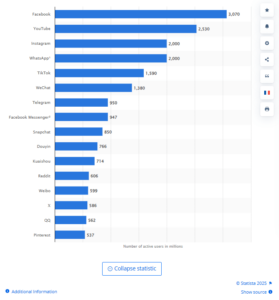
Which means your audience is there. And that’s just one of the reasons why you should have a Facebook presence.
In our guide, we’ve gathered actionable tips on how to build a successful Facebook marketing strategy for organic outreach and paid Facebook ads.
But let’s kick off with the basics: what is Facebook marketing and why you need it.
Reach your customers where they are
Go from Facebook to inbox and keep the conversation going.
Start FreeWhat Is Facebook Marketing?
In Facebook marketing, brands use the platform to promote their products/services and expand their reach to diverse audiences there.
It involves both organic strategies like posts and videos and paid advertising in the form of ads.
Facebook marketing offers a range of options to engage your audience:
- Create discounts and coupons to inform people about your offers
- Use boosted posts to tap on more opportunities (also available on the Pages Manager app)
- Build a strong community to help people with similar interests connect and learn with Facebook Groups
- Showcase your products/services on Facebook’s Marketplace
- Set up and promote an upcoming event through Facebook Events
These are just some of the use cases the platform provides its users. If you’re still not convinced, keep reading to understand the benefits of Facebook marketing for your business.
Benefits of Using Facebook Marketing
Facebook has been around for long. Some marketers marketers think this makes it irrelevant. But the truth is that for many users, it represents the main source of information.
They use it to search for brands, products, and services. More importantly, it’s the social platform they’ll turn to when looking for connections-either with friends and family or businesses.
On top of that, here’s why you Facebook marketing is a cornerstone of your social media strategy:
- Variety of content types: Facebook supports both text and visual formats in posts and paid ads to catch your audience’s eye. Informative videos, fun Stories, impressive Carousels-you name it. Just study your ideal user personas to identify the content types that best resonate with them.
- Organic traffic opportunities: Not all brands have the budget to leverage Facebook ads. What you can do is share value-packed content on your page. The more value you bring, the more the chances of getting your messages in front of the right people-and build connections organically.
- Powerful targeting using ads: With Facebook ads, there’s a set of ad options to find the type(s) that best fit your objective. Video ads are ideal for customer testimonials and how-to product videos. Whereas carousel ads could serve different objectives like showcasing multiple products in the same ad or telling a story.
- Detailed audience insights: Meta Business Suite lets brands access key insights on their current and potential audience demographics (e.g., age, gender), location, and interests. Using the data, you can inform your efforts to target them with laser-focused content.
- Measurable outcomes: Facebook provides a set of metrics, such as likes, comments, shares, etc. so you can dive deep into your audience’s engagement patterns. The platform’s analytics will also how different pieces of content (including Reels and videos) or ads are performing. When it comes to ads, Meta Ads Manager is a valuable tool that measures important KPIs like clicks and conversions.
How To Create A Facebook Business Page
Imagine that you want to approach specific customer personas on Facebook to boost brand awareness and conversions.
Your Facebook Page will be the place where everyone gathers up to learn your business news and updates, search for products, and make queries.
Creating a Facebook Page is no rocket science. It’s free, too. However, you’ll need to spend some time optimizing it for success. Here are some initial steps to follow:
If you already have a personal profile, find the “Pages” option on the left dropdown menu and select “Create new profile or Page.”
Then, choose between creating a personal profile or a Public Page, or update your existing profile. By selecting to create a public page, you’ll land here:
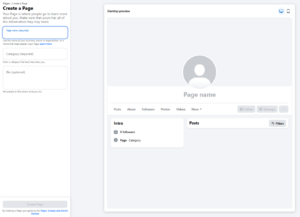
Complete the “Page name,” which is your company name, the category of your business (e.g., Restaurant) and tell people what you do in the “Bio” section. Add a logo or a distinctive image as your profile picture around 320 x 320 pixels to maintain high quality.
Consider inserting a complimentary “Cover Photo” that could depict your physical store(s), a selection of your products/services, or a current marketing campaign. The suggested size is at least 400 pixels wide and 150 pixels tall.
Facebook also allows you to add a call-to-action that directs users to perform a specific action, such as visiting your website, signing up, or even donating to a cause if you’re a nonprofit business.
Here’s Moosend’s Facebook page to use as a reference, including a CTA to prompt people to sign up:
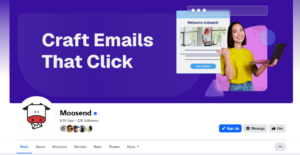
Optimize your Facebook Page
Now it’s time you gave more life to your Facebook Page:
- In the “About” tab, apart from the description, fill in your website, contact details, open hours, links to additional social channels, privacy and legal info, etc.
- Make sure that this section clearly communicates what you bring to the table without overstuffing it with keywords or unnecessary details.
- Under your page name, you can find and change your Facebook URL. This URL is unique for each business and helps visitors find you faster online.
- If more than one people work on this platform, you can assign different roles based on their responsibilities. Apart from the admin that has full access to all page aspects, you can include an editor, moderator, analyst, etc.
- If you want to increase the authority of your page, you can also request a verified badge from Facebook. This way, people who land on your website will trust you faster.
- Keep a mobile-first mindset, ensuring every page asset looks good on smaller devices.
Here’s how Headspace makes the most of its “About”section by inviting visitors to sign up and try their app for free through a straightforward call-to-action. Plus, they make sure to add links to other key social media channels to maximize engagement:
And just like that, your Facebook Page is ready to roll. Don’t forget to follow your brand guidelines when setting it up to help visitors to familiarize themselves with your business.
How To Promote your Facebook Page
With your Facebook Page up and running, it’s time to invite customers and prospects over to have a look.
Invite People Who Are Likely Interested
First off, you can rely on people who already know you or have heard of your business to support you. They may have liked your posts once or twice, or even share them with their followers. So, why not invite them to follow you?
You can also click on the three dots on the right and choose the “Invite Friends” option. It’s best to stick with people interested in your products/services to avoid being spammy or irrelevant.
When you finish this initial outreach, encourage your colleagues, friends, and satisfied customers to follow the same process to build a social network like no other.
Add Facebook Buttons on Other Channels
To increase your lead generation on Facebook, don’t limit yourself to the platform itself. Instead, you can cross-promote it on different touch points to expand your reach.
For example, you can add social buttons to a prominent place on your website to enhance your social media marketing efforts.
If you have a blog or YouTube channel, feel free to share a Facebook button there, as well, to align your social with your content marketing practices. And, of course, cross-promote it on other social channels like LinkedIn or Instagram if you see fit.
And let’s not forget your email campaigns. You could keep things simple by including a Facebook button to the email footer of your newsletters to attract the audience that already interacts with your brand.
But why leave it there? Consider creating dedicated emails to inform recipients about your Facebook presence and invite them to engage with your page and promotions.
In the email below, you can see how Miro uses clear and prominent social media buttons to encourage its subscribers to engage on more touch points:
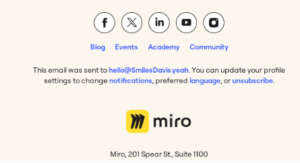
You can create these emails quickly using email marketing services like Moosend, offering intuitive drag-and-drop editors, professional newsletter templates, and personalization capabilities, among others.
Avoid Buying Likes
Many businesses are tempted to buy page likes to trick the Facebook algorithm. Though it might be tempting to adopt this practice to get things moving fast, it hardly ever works.
You can never be 100% sure about the origins of these likes come from. Fake or compromised accounts almost mathematically lead to low engagement rates.
What matters the most to Facebook’s algorithm is how likely it is for users to engage with a post based on their behavior. So, purchased likes won’t bring new Facebook users to you; your content and focused targeting will.
There’s an even more serious reason to stay away from this tactic: the platform may pick up on it and shut down your page with no prior notification. All your efforts will go down the drain just like that.
In a nutshell, it’s best to choose a slower but safe pathway to Facebook promotion and grow a community of interested followers instead of rushing into it. The more you interact with them, the higher engagement and visibility you’ll receive over time.
Facebook Marketing Strategy: Tips For Success
You need a solid marketing plan to skyrocket your social media marketing game. Here’s how to streamline a successful Facebook marketing strategy:
1. Define Your Target Audience
First and foremost, to define your Facebook target audience, you should learn about them as much as you can. Before building your Facebook content strategy, you should answer questions like:
- Who do I want to reach/sell to?
- What are their pain points?
- What type of content do they prefer to see?
- What is their primary reason for visiting Facebook?
Apart from their demographics, such as age, gender, and location, focus on collecting info about their purchase aspirations, interests, and challenges. Also, what kind of material they need to reach their goals. You can gather that information by conducting prospect and customer surveys or interviews.
Besides that, turn to Meta Audience Suite to get a better understanding of your existing and potential audience. Besides their engagement with your content, you can monitor things like their purchasing habits and devices they use to browse the platform.
Another great option includes detecting lookalike audiences to the ones who interact with your page, so you can expand your targeting.
You can also reach out to your internal teams, such as sales, customer support, and product development, to give you more insights into what makes a loyal customer. Based on their remarks, you’ll be able to plan a detailed and effective Facebook content strategy.
Ok, you collected the data. What’s the next move? Building detailed buyer personas that further help you understand your audience, identify their content needs, and upload relevant posts.
2. Set Goals
Now it’s time you established your Facebook marketing goals. Sure, these may evolve as your business and community grow. But to ensure that everything goes in the right direction, you should get as specific as possible.
Let’s have a look at some common goals that you might reach using Facebook:
- Bring traffic to your website
- Driving more sales
- Acquiring and nurturing leads
- Boosting brand awareness
- Enhancing customer support
- Recruiting talent
For example, if you’ve just launched a Facebook Page for a new business, you can determine a target of page likes and followers you want to reach to raise awareness. On the other hand, if you run a large business, lead generation is more likely under your radar. Engagement rates, such as likes, shares, and CTR, have undoubtedly become a priority for you.
Finally, setting clear and measurable goals lets you take control of your strategy and identify which metrics matter the most. Also, which tactics and content formats will help you reach success. Just make sure you revisit your objectives regularly to update them as your business needs change.
Remember, social media management is an ongoing process, especially with the rapid changes occurring in the algorithm. The same goes for consumer habits and preferences.
3. Create the Right Content for your Audience
One of main reasons why brands conduct thorough research before marketing their products/services comes down to this: understanding what kind of content they’re after.
For instance, 45% of consumers follow brands on social because they find their content fun and entertaining. If your customers have the same intent, you’ll want to target them with video posts, GIFs, and memes.
What if your ideal customer base are older adults that look for valuable insights? Then, you’d better rely on informative material that helps them see the value of your offerings-customer testimonials, industry news, and informative videos being your safest bet.
For better results, make sure you mix different types of content based on each audience group’s needs and preferences. Here are some of the content types you may choose from:
- Images: They can combine graphics and text, usually including a CTA. It’s better to invest in branded, high-quality images instead of stock images that seem outdated and amateurish. You can use them to showcase new products/services, announce giveaways, or share inspiring stories just like Starbucks did with this touching post:
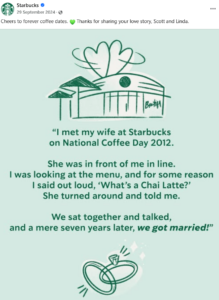
- Videos: A digestible and engaging content format that helps brands entertain, educate, and offer value effectively. For optimal engagement, keep in-feed videos shorter than 3 minutes. Also, keep in mind that many users display videos with the sound off. So, make sure you add some context using text to convey the message to people using this setting.
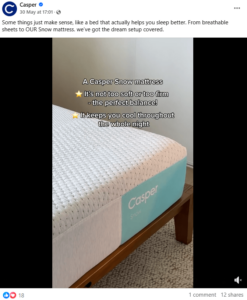
- Facebook Stories: Short videos or images that disappear after 24 hours. Users have the option to react or reply with a direct message through Messenger. To make them even more engaging, you could add music, emojis, stickers, location tags, and other fun elements.
- Facebook Reels: Short-form, entertaining videos designed to share industry expertise, showcase your products in action, or let users see what’s going on behind the scenes. This content type serves a great way to bring more people to your Facebook Page since they are displayed to non-followers, too.
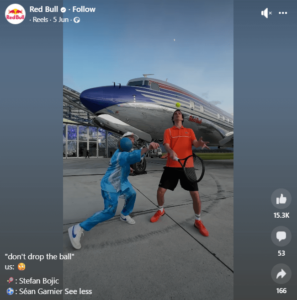
- Link Posts: A post with a clickable link to generate traffic to specific web pages. While this is a clever way to encourage users to take action, you should be cautious with this tactic. Facebook doesn’t want its uses to leave the platform, so it’s not unlikely to penalize posts using links.
- Facebook Live: Live broadcasts offer you the chance to engage with your audience in real-time. Due to its interactive nature, it’s a great tool to start conversations and forge deeper connections through live comments, reactions, and questions.
If you’re a Facebook marketing newbie, there are many opportunities to unleash your creativity. Another thing is to look at what your most experienced competitors are doing before you find your footing.
4. Build a Social Media Content Calendar
If you want to build a top-notch content strategy for your Facebook account, uploading content every now and then won’t cut it. It’s important to keep track of what you post, including the type, date, and time.
How can you do that? All it takes is a social media calendar will help you keep track of important information around content creation. Add all the necessary info every social media channel. Write down things like:
- Campaign name
- Content types and themes
- Posting date and time
- Creative assets like copy and visuals
- Team members responsible for each task
- Deadlines for completion
Also, you should always stay aligned with your audience behavior and preferences. This practice involves identifying patterns that work for your audience, such as best posting times to target them with the right message at the right time.
Moreover, maintaining a consistent and frequent schedule trains your followers to expect your posts at specific times. Which is a prerequisite for keeping your brand top of mind and achieving consistent engagement.
5. Try a Facebook Chatbot
Remember how we talked about improving customer service with Facebook marketing? Responding to them through the Messenger app seems relatively simple. Nonetheless, it’s not always resourceful for your teams. You see, regardless of the query, checking and addressing them takes time.
Here’s where Facebook chatbots steps in to save the day. With such an AI-enabled bot, you get to interact with customers in real-time through Messenger. Here are some of the most common use cases for this time-saving tool:
- It automatically answers customers’ questions and offers them relevant tips
- It delivers informative content to optimize the customer experience
- It books calls depending on the issue and your team’s availability
- It informs customers about order and shipping statuses
- It hands queries off to customer support in more complex scenarios
Another important advantage of using this tool is that you can feed it with your brand guidelines and ready-made scripts for different use cases. Therefore, each time they answer a customer question, you’ll be sure that it matches your brand tone. Which, in turn, ensures a consistent customer experience.
6. Measure your Facebook Performance
You can’t build a successful strategy without looking into data. Measuring your Facebook marketing performance allows you to identify the tactics that bring results and the ones that don’t. Based on the insights, you’ll be able to adjust your tactics down the road.
With Meta Business Suite, you can overview the most essential metrics and get a clear picture of your audience engagement. But let’s see the most important analytics available in the Insights section:
- New likes: The number of new likes that your page got
- Page reach: How many people viewed content from your page or other information about it (e.g., posts, ads, mentions
- Page views: The number of times people checked out your page
- Posts ROI: The return of investment of all your posts during a specific time frame
- Post impressions: How many times your content was shown to users
You can also use Facebook Ad Manager for more sophisticated data that will enable you to revisit your buyer personas from time to time. There, you’ll find insights regarding demographics – e.g., age, job title, relationship status, etc. – interests, hobbies, and lifestyles.
How to Nail Organic Facebook Marketing
In this section, we’ll explore how to grow your Facebook channel organically to meet your marketing objectives. No matter if you work for a local business or a large corporation, these tips are exactly what you need to bring your A-game in Facebook marketing:
Optimize For SEO
Search engine optimization (SEO) is the bread and butter of an inbound digital marketing strategy, and you can apply its rules to your Facebook page, too.
The best way to start is performing keyword research, an activity that facilitates finding the queries customers in your niche market look for. Let’s see some quick and easy tricks:
- Customize your page name: Consider adding a relevant keyword to your page name to increase the chances of ranking high.
- Optimize your vanity URL: Create an easy-to-spell domain name that includes your brand name to help people find your page.
- Implement keywords where needed: Include your chosen keywords in key page assets like your URL, captions, and your profile picture.
- Rewrite your “About” section: Write a short yet informative description for your business and add relevant keywords throughout it to boost rankings.
- Share relevant content: Add relative terms to your captions and alternative text to appear higher on search results.
- Include your contact details: Ensure your page includes contact info (e.g., phone number, address, email) and that you keep them updated.
For instance, we use Ahrefs to conduct keyword research. You can choose some of the keywords suggested and sprinkle them smartly throughout your content when you complete this process.
However, make sure you don’t sacrifice quality for the sake of keyword-stuffing. As a rule of thumb, add keywords where they make sense without forcing them.
Choose Optimal Posting Times
When do your followers visit Facebook more often? Is it on weekdays or weekends? Knowing when most of your customers hang out in their newsfeed is key to attracting their attention faster and driving more clicks.
Before you start drawing data patterns from your fan base, you can make some initial assumptions based on their demographics and browsing behavior. For example, some people scroll through social media during their lunch break while others log in first thing in the morning.
And for those in need of a cheat sheet, here are some updated global Facebook engagement data by SproutSocial for maximum performance:
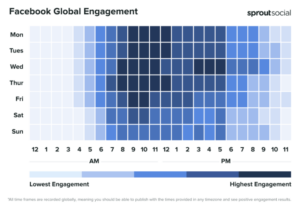
Generally, the findings indicate that the best days to post on Facebook are Mondays through Fridays while the worst day is Sunday. The times range from 9 a.m. to 5 p.m. depending on the day of the week.
Get Your Employees Onboard
The Facebook algorithm favors content with high engagement rates, resulting from reactions, shares, and comments. But no matter how great your content is, it might be hard to claim them initially.
And that’s when your team members can step in for support. Ask your colleagues to be the first who will react and comment on your posts to increase engagement. You can also invite them to share your best or new content via email or your internal communication tool, including great copy they can use.
To get their buy-in, explain all the benefits your business can offer through these seemingly simple moves. Once your posts start to gain traction, new people will discover you, and if they’re interested in what you οffer, they will finally give you their golden page like.
Boost Lead Generation Activities
It’s only natural to want to gain more leads and start collecting valuable information. For instance, get your users’ email so you can send them value-packed email newsletters.
To get there, here are some content assets that will bring you conversions:
- Landing pages
- Sign-up forms
- Webinars and events
- Blog posts with high conversion rates
You can also test different types of lead magnets from time to time to attract a diverse and see what works best for them. For instance, one audience group could care for a free trial while another for a discount code.
Plan a Giveaway
Who said that giveaways are solely for Instagram and Tiktok? You can also host a giveaway contest on Facebook to maximize your reach. Or leverage your Instagram giveaway to kill two birds with one stone.
In addition, you can increase your follower base, drive engagement, and promote some of your unique products/services. Here’s how to do it successfully:
- Set a goal for your giveaway
- Select an attractive prize that your audience wants
- Define the giveaway entry rules (e.g., like the page, tag a friend)
- Fill out a form
- Pick a date to announce the winner
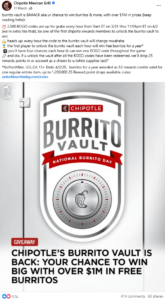
Apart from choosing an attractive prize for the winner, create a short and beautiful post with fun and clear copy, to avoid miscommunications with the contestants. And of course, wish them the best of luck!
Interact With your Audience
To increase Facebook engagement, you need to start meaningful conversations with your audience. Always respond to comments, especially those addressing important questions, and show your customers and prospects that you care.
Moreover, always check Facebook Messenger and reply to all the messages you receive there. Consumers appreciate brands that are responsive to them so they’ll definitely stay around if your products/services and content resonate with them.
Also, don’t sit back and wait for your followers and visitors to interact with your content and page. Adopt a bolder approach by requesting engagement. Share polls and encourage them to vote. Ask them a question and urge them to reply through a comment. Suggest they invite their friends to like the page.
Overall, those interactions can also shed light on your customers’ biggest pain points and interests. Later on, you can use this new perspective to improve your offerings and interactions with them in the future.
Build a Facebook Group
If a user wants to become part of a social media community, chances are they’ll pick Facebook. So, if you want your customers to feel like part of a community, create a Facebook Group. There, like-minded people interested in your brand and offers can enter and share insights.
Also, it’s a great place to promote customer loyalty, perhaps by offering some targeted, members-only content or deals. Whatever you choose, ensure your focus point is to help users make the most of your value proposition.
You may ask yourself: “What’s in it for me?”. Well, here’s what you gain from building such a community:
- Get your content and products/services in front of your most qualified leads
- Gather valuable customer feedback
- Showcase your expertise and establish your authority among peers
Facebook Ads: Creating Highly Targeted Campaigns
Even though the value of organic reach is undeniable, sometimes you need to plan highly targeted marketing campaigns to meet your objectives. Facebook enables you to create ads giving you plenty of opportunities to reach the right audience for your business.
You can manage the whole advertising process through the Meta Ad Manager dashboard. This process seem overwhelming at first since it requires some time, research, and continuous testing.
But the Meta Manager makes things easier, breaking up the process in simpler steps. You get guidance throughout the process, from choosing your specific goal to finding the ad format.
So, these are the essential steps for creating an effective Facebook ad from start to finish:
1. Choose your Marketing Objective
Once you’ve set up your business profile on Meta Ad Manager, you can start building your first campaign. The first step is to define your campaign objective. Some of the business goals offered include awareness, lead generation, and sales.
After picking your marketing objective, you should choose a descriptive campaign name. Before moving to the next step, Facebook requires you to specify whether your ads are related to a specific category, such as employment, housing, or social issues.
Moreover, you can choose if you want to A/B test different ad versions to find the most successful ones at this initial step.
2. Define Your Budget & Schedule
Once you’ve chosen the page you’d like to convert, e.g., your website or Facebook page, you can define your budget and schedule your ads. You have two main options:
Daily budget: Set the average amount you’d like to spend per day. This ad is going to run continuously.
Lifetime Budget: With this option, you set the total amount you want to spend over a specific timeframe (your campaign’s runtime).
Finally, when scheduling your ad, you have control over the dates and times when your ads are displayed. If you don’t define an end date for your campaign, you can always turn it off whenever you want. take the timezone of Facebook users into account for maximum results:
3. Determine Your Audience
Now, it’s time you selected the audiences you’d like to reach. You can specify demographic information such as age and gender or location. More advanced settings allow you to further optimize your targeting. For example, you can exclude a custom audience or add criteria like minimum age.
If you want the Facebook to help you improve your performance, the Suggestions option allows the platform to display the ad to groups outside of your choices.
Facebook also gives you the ability to find lookalike and custom audiences to bring better results. Plus, you can save audiences that you target often to easily reuse in future advertising efforts.
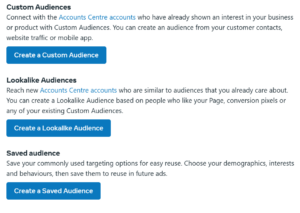
Moreover, through Facebook retargeting ads, you access consumers that have already visited your website to nurture them until they convert.
4. Select The Right Ad Format
There are many formats to choose from based on your customer’s needs to structure a successful ad. Let’s have a look:
Photo: Ads with static images in PNG or JPG format. You can use them to showcase how people are using your products/services. Avoid cluttering your photo ad with too much copy since it will probably distract people from your core message.

Videos: Video ads in MP4, MOV, or GIF. Video captions are recommended to make these assets accessible to everyone.
Stories: An ad format that appears in-between the Stories that users see. Their main benefit is that they’re easily digestible and engaging.
Carousel: A collection of images and/or videos ideal to introduce customers to a wide range of your products, all in a single ad.
Collection: Up to five images that show up on mobile devices. It simulates window-shopping so users can scroll through different products.
The ad format you select depends on things like your industry and company size. For example, large eCommerce businesses with a variety of product lines could better benefit from collection ads compared to a local store with limited offerings.
5. Monitor Key Ad Metrics
It’s impossible to form a successful Facebook advertising strategy without keeping a close eye on ad metrics. Here’s what to consider:
- Impressions
- Reach
- CTR (Click-through rate)
- CPC (Cost per click)
- Conversions
- ROAS (Return on ad spend)
This set of data helps you figure out whether you achieved the desired result. Also, they enable brands to understand when and why their advertising efforts underperform and make adjustments.
Keep in mind that no magic formula can apply to all businesses. This is why you should keep monitoring key metrics to find out what works best for your target audience and make adjustments.
Take Facebook Marketing To The Next Level
Now that you’ve learned all the benefits and different opportunities of Facebook marketing, it gets tough to ignore it. If you don’t already have a Facebook page, build one asap and start promoting your brand to users that are highly likely to convert.
If your business is new, start with organic marketing techniques. You can move on to paid ads as your business grows to expand your reach. You can also run retargeting campaigns to discover lost opportunities among consumers that have already interacted with your brand.
Are you interested in building an omnichannel marketing experience? Sign up for a free trial with Moosend and promote your Facebook page to all your subscribers in simple steps. Just design a beautiful email footer with our drag-and-drop editor and bring them over to your Facebook page.



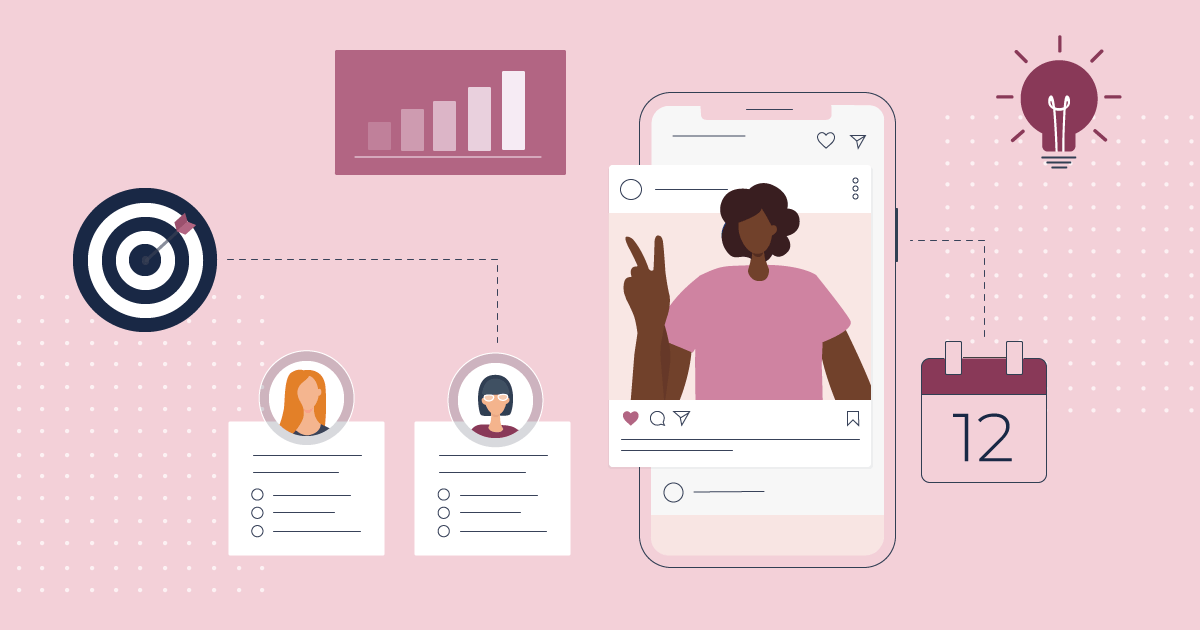

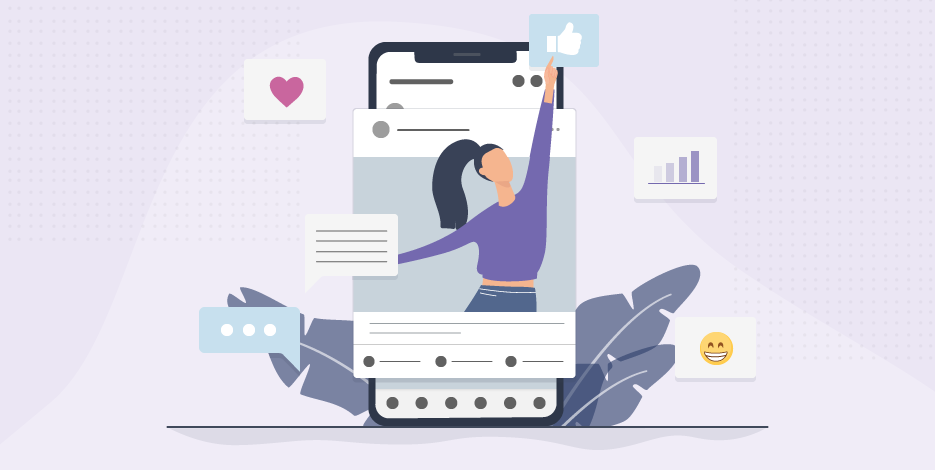
 Published by
Published by